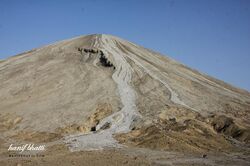Chandragup
Topic: Earth
 From HandWiki - Reading time: 2 min
From HandWiki - Reading time: 2 min
Chandragup is an active mud volcano located in Hingol National Park in Balochistan, Pakistan .[1] Also known as Chandrakup, the volcano is considered holy by Hindus and is an important stop for pilgrims on their way to the shrine of Shri Hinglaj Mata temple.[2]
| Baba Chandrakup چندرگپ चन्द्रगुप | |
|---|---|
 Baba Chandrakup | |
| Religion | |
| Affiliation | Hinduism |
| District | Lasbela District |
| Deity | Baba Chandrakup (Lord Shiva) |
| Festivals | Four Day Theerth Yatra in April(Hinglaj Yatra) |
| Location | |
| Location | Hinglaj |
| State | Balochistan |
| Country | Pakistan |
| Geographic coordinates | [ ⚑ ] 25.0°26′43.33″N 65.0°51′55.55″E / 25.4453694°N 65.8654306°E |
| Expression error: Unexpected < operator. | |
| Elevation | 100 m (328 ft) |
| Website | |
| www | |
The Chandragup mud volcano is worshipped as an embodiment of the Hindu god Shiva, and called Baba Chandragup. Pilgrims to the volcano believe that the Shri Hinglaj Mata temple may only be entered only after paying homage to Baba Chandrakup. Traditionally, the pilgrim stays awake all night, fasting and meditating on the sins they will confess at the rim the following day. They bake roti made out of ingredients contributed by all the yātrīs.[clarification needed] On the next day they ascend the slope of Chandrakup, and the roṭi is served as an offering to Baba Chandrakup. Nowadays, coconuts, betel nut and dal are also offered. At the volcano's peak, the pilgrims must introduce themselves with their full name and place of origin and then call out their sins in front of the group. According to the bubbling of the mud and the reaction of the wind, the chaṛīdār is able to tell if the pilgrim's sins are forgiven.[3]
Devotees throw coconuts into the craters to make wishes and thank the gods for answering their prayers.[4]
See also
- List of volcanoes in Pakistan
- Shri Hinglaj Mata temple
- Hinduism in Balochistan
References
- ↑ Muddy Coasts of the World: Processes, Deposits, and Function, pp. 149, Gulf Professional Publishing, 2002, ISBN:9780444510198, ... The Las Bela Coastal Plain in Baluchistan is also renowned for the occurrence of mud volcanoes (Snead 1964). The largest one of these, the Chandragup, forms an almost perfect cone 58 m high ...
- ↑ Mud Volcanoes of Balochistan , Owais Mughal, 2 March 2007, All Things Pakistan, Accessed: 25 September 2012, ... Very close to Chandargup is an ancient Hindu temple called ‘Hinglaj temple’ or ‘Nani Temple’. There are many pronunciations of the word Chandragup in practise. Due to close proximity a Hindu temple to these volcanoes, it is very likely that the word Chandargup is actually derived from the word ‘Chandargupt’. Another word which locally mentions this group of volcanoes is ‘Chandra coop’ which means Volcanoes of the Moon ... The Hindus worship these mud volcanoes as the habitation of a deity Babhaknath ...
- ↑ http://40.114.28.106/PDF/5322-pdf-VNV/p2/9780190850531.PDF
- ↑ "Hindu Pilgrimage in Pakistan". 10 January 2019. https://www.nationalgeographic.com/culture/2019/01/muslim-majority-country-hindu-goddess-lives-pakistan-pictures/#/18_hindu_pilgrimage_mmi8851_180405_2272.jpg.
 KSF
KSF